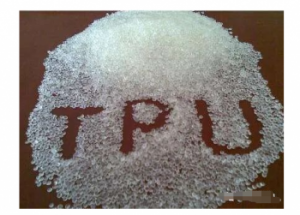Abstract
The present invention is a high solid content polyurethane ink resin, preparation method and its application. The said resin is produced by reacting raw materials containing the following mass parts: 28 to 46 parts of compound polyol, 3 to 15 parts of polyisocyanate, 2 to 9 parts of functional amine chain extender E, 0.1 to 13 parts of functional capping agent T, and 30 to 60 parts of solvent. The polyurethane resin of the present invention has a low viscosity and high molecular weight at 45% solid content or more, and the prepared ink has excellent leveling, adhesion fastness, and anti-adhesive properties.

Wherein, said polymer polyol refers to polyester polyol or polyether polyol, polyester polyol is a terminal hydroxyl polyester compound generated by the condensation of a diol with a diacid. Examples of said diols include, but are not limited to, ethylene glycol, 1,2-propanediol, 1,3-propanediol, methyl propylene glycol, 1,3-butanediol, 1,4-butanediol, neopentyl glycol, 1,6-hexanediol, 3 -methyl-1,5-pentanediol, 1,4-cyclohexanediol, dihydroxydiphenyl sulfone, 2,2-bis(4-hydroxyphenyl)propane, 4,4 ‘-dihydroxydiphenylmethane; examples of said diacid include, but are not limited to, at least any one of sebacic acid, adipic acid, azelaic acid, terephthalic acid, isophthalic acid, phthalic acid. Preferably, said polyester polyol has a functional degree of 2.

As said polyether polyol refers to a compound formed by the initiation of a hydroxy compound and the polymerization of an epoxy alkane, examples of hydroxy compounds commonly used as initiators include, but are not limited to, ethylene glycol, diethylene glycol, 1,2-propanediol, 1,3-propanediol, dipropylene glycol, 1,2-butanediol, 1,3 -butanediol, 1,4-butanediol, hexanediol, pentanediol, 3-methyl-1,5-pentanediol, 1,8-octanediol, 1,9- nonanediol, 1,12-dodecanediol, at least any one of catechol, resorcinol, bisphenol F, and bisphenol A. Examples of epoxyalkanes include, but are not limited to, at least any of ethylene oxide, propylene oxide, and epoxybutane. Said polymeric polyol has a number average molecular weight of 400 to 6000, for example including but not limited to 800, 1500, 2000, 3000, 4000, 5000, preferably 1000 to 4000.

Examples of said polyisocyanates include, but are not limited to, toluene diisocyanate (TDI), diphenylmethane diisocyanate (MDI), isophorone diisocyanate (IPDI), hexamethylene diisocyanate (HDI), dicyclohexylmethane diisocyanate (HMDI), naphthalene diisocyanate (NDI), p-phenylene diisocyanate (PPDI), 1,4 -cyclohexane diisocyanate (CHDI), benzodimethylene diisocyanate (XDI), cyclohexane dimethylene diisocyanate (HXDI), trimethyl-1,6-hexamethylene diisocyanate (TMHDI), tetramethyl isophthalene diisocyanate ( TMXDI), norbornane diisocyanate (NBDI), dimethylbiphenyl diisocyanate (TODI), at least any one of methylcyclohexyl diisocyanate (HTDI). Preferably, said polyisocyanate is one or more of toluene diisocyanate (TDI), isophorone diisocyanate (IPDI), hexamethylene diisocyanate (HDI), dicyclohexylmethane diisocyanate (HMDI).
In the synthesis of the isocyanate prepolymer in said step 3), said catalyst may be a catalyst commonly used in the art, examples of which include, but are not limited to, dimethyltin diacetate, dibutyltin dibutyrate, dibutyltin di(2-ethylhexanoate), dibutyltin dilaurate, dioctyltin dilaurate, zinc(II) dioctanoate, zirconium acetylacetonate, 2,2,6. 6-tetramethyl-3,5-heptanedione zirconate and at least any one of bismuth 2-ethylhexanoate; preferably dibutyltin dilaurate, bismuth neodecanoate and bismuth 2-ethylhexanoate, further preferably bismuth neodecanoate and bismuth 2-ethylhexanoate. -Bismuth ethylhexanoate.
Wherein said solvent is selected from one or more of ester, secondary alcohol, tertiary alcohol solvents; preferably one or more of ethyl acetate, n-propyl acetate, isopropyl acetate, n-butyl acetate, isobutyl acetate, isopropanol, more preferably one or more of ethyl acetate, n-propyl acetate and isopropanol. It should be noted that the specific type of solvent used in said step 2) and step 3) can be the same or different, serving to dilute and dissolve, without affecting the implementation of the present invention.

